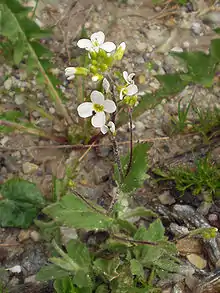Arabis alpina
Arabis alpina, the Alpine rock-cress, is a flowering plant in the family Brassicaceae, native to mountainous areas of Europe, North and East Africa, Central and Eastern Asia and parts of North America. In the British Isles, it is only known to occur in a few locations in the Cuillin Ridge of the Isle of Skye. It inhabits damp gravels and screes, often over limestone.
| Arabis alpina | |
|---|---|
 | |
| Scientific classification | |
| Kingdom: | Plantae |
| Clade: | Tracheophytes |
| Clade: | Angiosperms |
| Clade: | Eudicots |
| Clade: | Rosids |
| Order: | Brassicales |
| Family: | Brassicaceae |
| Genus: | Arabis |
| Species: | A. alpina |
| Binomial name | |
| Arabis alpina | |
| Synonyms | |
|
Arabis merinoi Pau | |
Description
The stems grow up to 40 cm (16 inches) tall, and are topped with loose heads of white, four-petalled flowers. The leaves in the basal rosette are long, strongly toothed and clearly stalked, although the stem leaves are stalkless and clasp the stem.
Taxonomy
Arabis alpina is believed to have originated in Asia Minor about 2 million years ago. From there it migrated twice into East Africa (500,000 years ago) where it grows today on the high East African mountains in the ericaceous belt. Another migration route led A. alpina into Europe which was then colonised periglacially. In genetic terms, the highest diversity is found in Asia Minor. In central and northern Europe, A. alpina seems to be genetically quite uniform.[1]
There is growing interest to develop Arabis alpina as a model organism for genetics, population genetics, and molecular biology. The first genetic linkage map has been created and the first phenotypes, especially perenniality, are tackled by QTL mapping.
Subdivision
A former subspecies, A. alpina subsp. caucasica, is now recognised as a separate species, Arabis caucasica.
See also
References
- M. A. Koch; C. Kiefer; D. Ehrich; J. Vogel; C. Brochmann; K. Mummenhoff (2006). "Three times out of Asia Minor: the phylogeography of Arabis alpina L. (Brassicaceae)". Molecular Ecology. 15 (3): 825–39. doi:10.1111/j.1365-294X.2005.02848.x. PMID 16499705. S2CID 8689166.